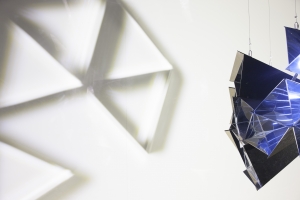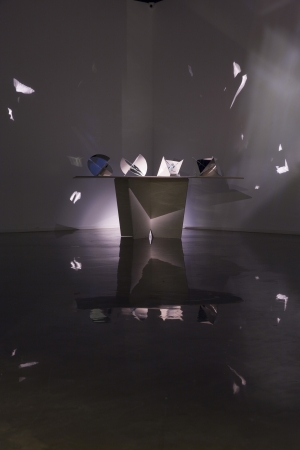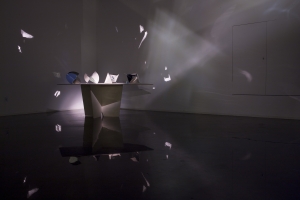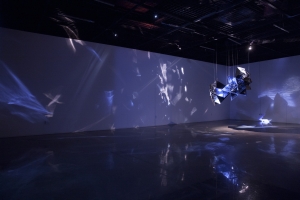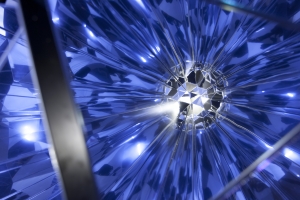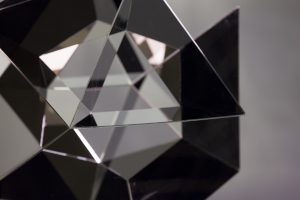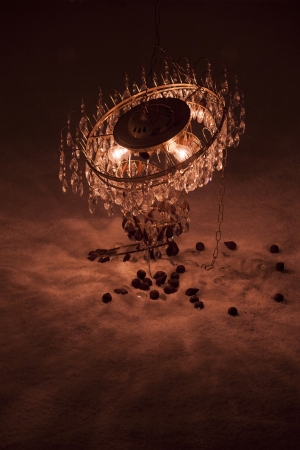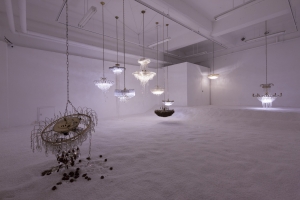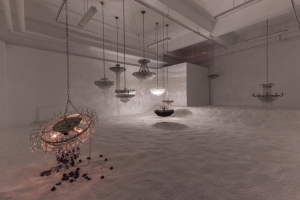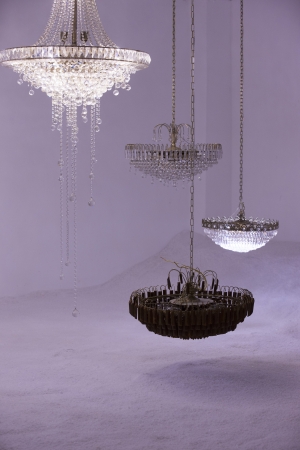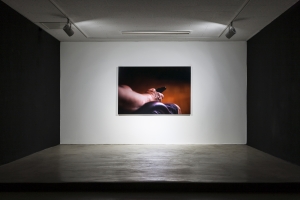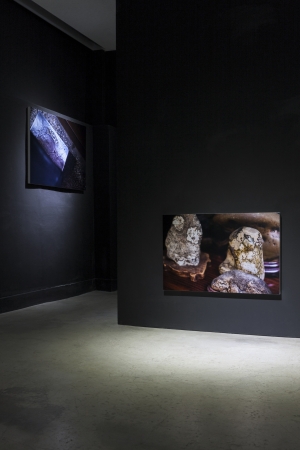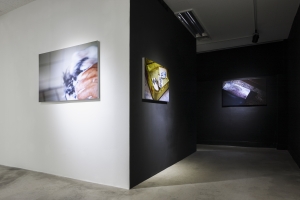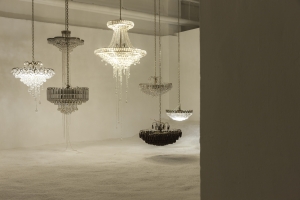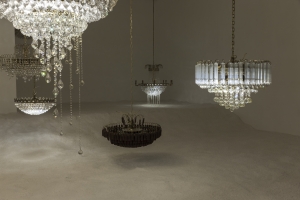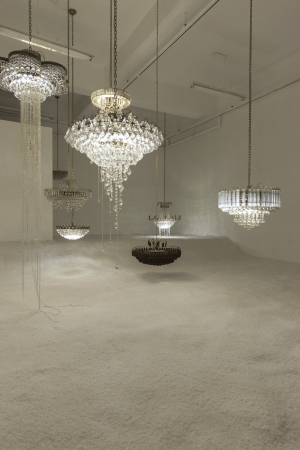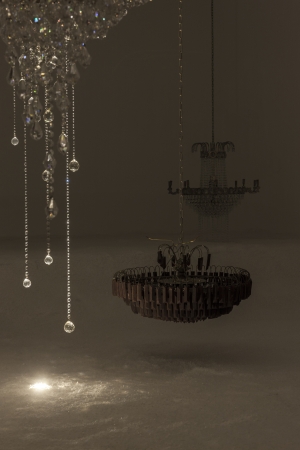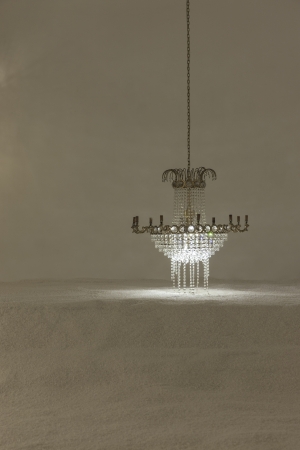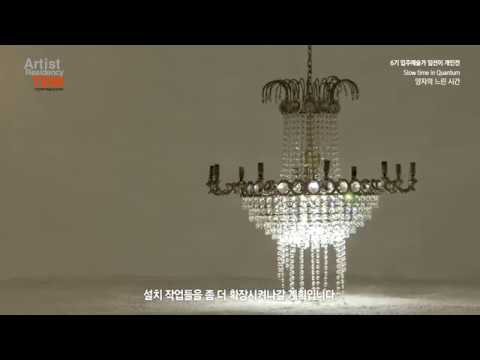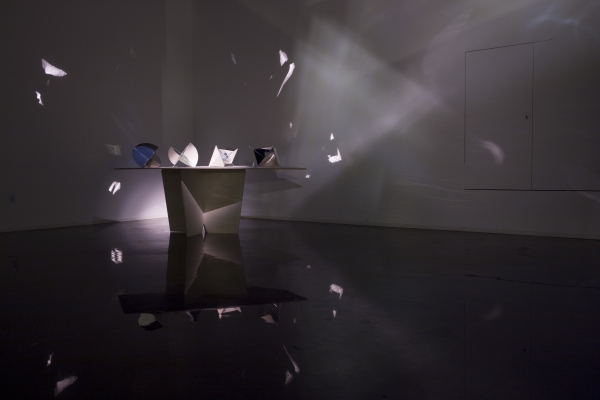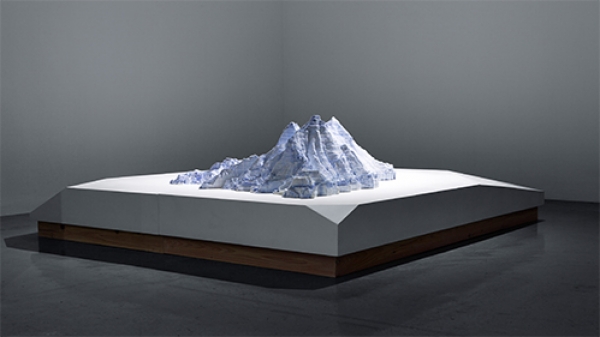전시 EXHIBITION
입주예술가 개인전Slow time in Quantum 양자의 느린 시간
-
108개의 면과 36개의 시선, 또 다른 한 개의 눈
-
108개의 면과 36개의 시선, 또 다른 한 개의 눈
-
108개의 면과 36개의 시선, 또 다른 한 개의 눈
-
108개의 면과 36개의 시선, 또 다른 한 개의 눈
-
108개의 면과 36개의 시선, 또 다른 한 개의 눈
-
108개의 면과 36개의 시선, 또 다른 한 개의 눈
-
108개의 면과 36개의 시선, 또 다른 한 개의 눈
-
108개의 면과 36개의 시선, 또 다른 한 개의 눈
-
녹슨 말
-
녹슨 말
-
녹슨 말
-
녹슨 말
-
유토피아
-
유토피아
-
유토피아
-
유토피아
-
녹슨 말
-
녹슨 말
-
녹슨 말
-
녹슨 말
-
녹슨 말
-
임선이 개인전 영상
대전에서 태어나고 살아온 두 나이든 남자의 노년의 삶을 통해 그들에게 다가온 느린 시간 안에서의 삶의 현상과 공존의 방법을 눈과 말과 손, 느린 기억의 회로, 몸의 무의식적 행위라는 주제를 가지고 전시가 펼쳐진다. 중첩되어 있는 손의 형태는 그들의 과거와 현재를 이야기하며 시간의 흐름에 흐릿해져가는 눈의 생각을 37개의 만화경과 숨쉬는 빛을 이용하여 여러 개의 시선을 담아낸다.
작품은 설치, 조각, 사진을 주매체로 다양하게 제작되어지며 각 매체의 특성을 살려 가까운 네러티브가 공존하여 보여주거나 함축적 힘을 가지고 시각적 반응을 불러일으키는 구조적인 작품이 전시되어 질 것이다.
-
우리의 삶이, 때때로 조각의 크기와 무게를 갖는다면
안소연 미술비평가
선인장을 화분 째 주물 떠서 회색 시멘트로 여러 개 만들어 바닥에 펼쳐 놓고, 눈을 번뜩이며 움츠려 걷고 있는 고양이의 형상을 브론즈로 매끈하게 떠내서 녹슨 조각 받침대 위에 올려 놓아, 그 평범한 형상들로부터 임선이는 우리에게 삶의 피난처를 떠올리게 했다. 작품의 제목은 각각
<양자의 느린 시간 Slow time in Quantum>(2019)은 세 개의 전시 공간을 아우르는 동선과 그 규모를 통해, 시각적으로 조율된 임의의 시공간을 새로이 가늠하도록 이끈다. 그것은 서사가 멈춰진 하나의 장면으로서, 이 정지된 순간은 마치 스스로의 속도를 무게로 응축시켜 놓은 듯 시간과 공간이 서로 어긋나버린 일련의 사건을 일으킨다. 무슨 말인가 하면, 어떤 시간성을 갖는 서사가 다수의 공간 안에 끌려 들어와 스스로의 무게를 지닌 형상으로 새롭게 구축되는 “조각적 사건”에 대해서 나는 상상해 보고 싶은 것이다. 어느 때인가, 내가 회색 시멘트 선인장과 브론즈로 만든 고양이를 봤을 때도, 그것들이 어디에서 어떤 서사를 가지고 여기로 온 것인가 보다는 그 형상들이 갖고 있는 무게가 어떻게 획득된 것인가를 나는 신중하게 생각했었던 같다. 그리고 그 무게란, 궁극적으로 조각의 무게였다고 이제 결론지어 본다. 그것은 <양자의 느린 시간>이 만들어낸 공간에서 그 시간의 속도가 무게로 응축된 사건을 목격한 후다. 그 무게를, 나는 열 장의 사진으로 구성된 <유토피아>(2019) 연작에서 강렬하게 감지했다. 흰 벽 중간쯤에 가로로 나란하게 놓인 흑백 사진 네 장을 지나, 중첩된 벽의 모서리를 사이에 둔 채 따로 놓인 세 장의 컬러 사진을 한참 서서 보고, 거기서 시선을 안으로 바짝 밀어 넣어야 닿게 되는 공간에 서로 다른 높이로 흩어 놓은 세 장의 또 다른 컬러 사진을 모두 보고 나서, 이 사진이 어떤 윤곽으로 포착해낸 무게에 대해 말할 수 있을 것 같았다. 그리고 그것의 무게를 인식하는 태도야말로 조각적 사유라 할 수 있지 않을까 하는 믿음을 순식간에 만들어냈다. 그럼, 나는 이 망상을 여기서 그만두지 않고 좀 더 계속해 볼 것이다.
다시, <유토피아>가 남긴 잔상을 떠올려 본다. 사진이 담고 있는 익명의 시간에, 임선이는 어떤 형태의 손을 몸에 지닌 한 사람을 바라보고 있다. 그리고 그 손은 한 사람의 몸으로부터 떨어져 나와 이제 제 생김새를 사유해낼 자리에 놓여 있다. 그러기 위해, 임선이는 사진 속 80대 이발사의 손과 한참 씨름했던 게 분명하다. 면도칼을 쥔 손과 누워있는 얼굴을 감싼 다른 손 사이의 긴장은 손가락 마디마디에 깊이 남겨놓은 흉터와 같은 자리에서 같은 시선으로 중첩돼, 유독 이 형태가 아무런 서사 없이 혹은 전체로서의 몸과 연결 없이 스스로 제 형태의 무게를 만들어내려 하고 있지 않은가. 말하자면, 임선이는 이 연속하는 사진들로 한 사람의 몸과 그것의 서사에 대해 기록하거나 사진의 지표적인 흔적을 남기려는 것도 아니었을 테고, 주물로 떠내 듯 어떤 완결된 형태로 놓일 수 있는 조각적 접근 방법을 찾는 것이었음을 막연하게나마 짐작해보면, 그는 사진에 맺힐 그 대상 자체가 스스로 조각적 크기와 무게를 만들어내는 일련의 완결된 장면들을 찾아 나섰던 게 아니었을까 싶다.
사물이 혹은 어떤 행위가 혹은 어떤 시선이 스스로 제 무게를 갖게 되는 순간에, 임선이는 조각에 다가간다. 80대 이발사의 손이 가로로 놓인 무채색의 평평한 사진에서, 허공 같은 흰 벽의 한가운데서, 오직 스스로의 무게를 형태 안에 가두는 조각적 사건을 그는 포착한다. 그 노년의 손은 몸의 지체로 살아온 속도를 차츰 잃어가는 대신 스스로 제 형태의 무게를 얻었으며, 시간을 살아가는 대신 공간을 점유하게 되어, 마침내 언젠가는 시간과 속도 같은 그 모든 것을 제 생김새 안에 집어넣어 단단한 무게만이 존재하는 어떤 공간에 이르게 되지 않겠는가. 거기가 사라진 시간들이 당도하게 되는 유토피아인지 알 수는 없다. 다만, 이발소 의자의 금속 발판에 선명하게 새겨 있는 “UTOPIA”라는 단어가 현실에 발 딛고 있는 누군가의 몸을 지탱해 온 시간만큼, 오래된 단어는 그 자리에 몸을 눕혀 생의 순간들을 준비하며 살아갔던 이들과 그 몸을 성실하게 가꾸던 이의 손이 제 스스로 갖게 된 시간의 무게를 나타낸다. 또 다른 사진에서, 80대 이발사의 손은 하얀 비누 거품에 덮인 머리를 만진다. 이때, 그 느린 손은 한없이 가볍고 미끄러운 거품에 제 무게를 맡긴 채 다른 몸과 교차한다. 그리하여 어떤 찰나에 이 모든 게 마치 하나의 물질로 뭉뚱그려진 덩어리처럼 보일 테고, 그 형태는 오롯이 그 덩어리만큼의 무게를 가늠케 할 것이다.
모퉁이를 돌면, 무언가 빠져나간 빈 철제 통에 오래된 군대 계급장이 들어가 있다. 한 계단 한 계단 오르던 발걸음이 어딘가에서 완전히 멈추고, 누렇게 뜬 종이에 매달려 내용물이 비워진 녹슨 철제 상자 안에 덩그러니 들어가 있은 지 오래다. 반짝이며, 아버지의 몸이 가볍게 지탱했을 저 표식들이, 시간을 잊고 스스로 제 무게를 만들어내고 있던 녹슨 자리를 본다. 그 물질의 무게를 눈으로 한참 가늠하듯, 임선이는 아버지의 군대 계급장과 그것이 놓인 자리의 현전을 살핀다. 가장 깊숙한 공간, 흰 색 벽 한가운데, 80대 이발사의 손처럼 허공에서 어떤 물질이 돼버린 것 같은 아버지의 손이 보인다. 그 형태가 마주하고 있는 또 다른 사진에는, 느린 손의 무게를 알리는 풍경과 장면이 마치 어떤 형태로 주물 뜬 것처럼 시간을 멀리하고 한 자리에 붙박혀 있다. 손으로 옮겨 삼켜지지 못하고 식탁에 떨어진 밥알만큼, 부지런한 손이 추억 속에 옮겨다 놓은 오래된 수석들만큼, 노년의 아버지가 지금까지 지내온 시간은 어떤 형태 안에서 묵직한 물질의 무게로 현전하고 있다.
<녹슨 말>(2019)에서, 임선이는 쓸모를 다하고 천장으로부터 내려진 오래된 샹들리에 열 개를 구해서 가져다가 전시장 천장에 매달아 다시 전원을 꽂았다. 깊이를 알 수 없는 비현실적인 두께를 가지려는 듯 바닥은 하얀 소금으로 전부 가려졌고, 화려했던 과거의 유물처럼 기능이 소실된 이 형태들은 스스로를 지탱하는 무게로만 현전을 나타낸다. 일련의 시간을 두고 서서히 점등했다가 서서히 점멸하는 이 연쇄적인 움직임과 각각의 형태들이 지니고 있는 단단한 물질과 심지어는 호흡처럼 간신히 내쉬는 빛의 파장들마저, 임선이는 이 모든 것을 존재의 무게로 수렴시킨다. 소금이 있는 바닥까지 완전히 내려와 있는 한 개의 샹들리에가 그것을 대표한다. 임선이의 시선은, 빛을 완전하게 지탱하여 공간 안에 지속시킴으로써 유토피아를 상상하며 현실을 화려하게 장식해야 할 샹들리에의 크리스탈 조각 부품들이 시간을 지나 마침내 소실되고 그 투명성을 상실한 것에 다가가 그 누락된 자리에 “녹슨 말”의 무게를 가져다 놓기로 했다. 임선이는 샹들리에의 화려한 형태를 촘촘히 엮던 작은 크리스탈 조각의 단위 형태를 주물로 본 떠 검붉게 녹슨 조각을 수십 개 만들어냄으로써, 천장에서 가볍게 반짝이던 샹들리에를 땅의 한 자리에 내려놓을 만큼의 무게를 얻었다. 이는, 생의 긴 서사와 상상의 미래를 꿈꿔왔던 화려한 빛의 순간들이 이러한 물질의 형태로 어딘가 두께를 알 수 없는 깊은 곳에서 스스로의 무게를 안고 현전하고 있음을 나타낸다. 임선이는 거기에 노년의 아버지가 가지고 있던 오래된 메모장 위의 녹슨 말들을 불러와 중첩시킨다. 미래의 시간으로부터 이제는 한참 멀어진 아버지의 과거는, 빛 바랜 메모지 위에 덩그러니 놓여 있는 말들의 모양을 본 떠 그만큼의 무게로 남게 될 것이다.
발 밑에 유토피아를 두고 미래를 꿈꿔왔던 80대 이발사의 손과 자신의 몸에서 빛나는 별을 꿈꿔왔던 아버지의 느린 손에서, 화려했던 빛이 서서히 점멸하여 이제는 제 형태와 무게만 지니고 있는 구식 샹들리에와 아버지의 오래된 메모 안의 녹슨 말들에서, 임선이는 노년의 삶을 조각의 형태와 무게로 사유하는 일련의 과정을 탐색했다. <108개의 면과 36개의 시선>(2019)은 그 연속에서 느린 손과 녹슨 말을 거쳐 흔들리는 눈으로 옮겨간다. 거울 면을 이용해 만화경의 구조를 설계한 <108개의 면과 36개의 시선>은 노화된 시력이 갖게 되는 불확실함과 폐쇄성을 암시한다. 탁 트인 전시공간을 암실로 변경하여 공간 전체를 두꺼운 가림막이 내려온 노인의 망막처럼 설계해 놓은 이 장소에 대한 경험은, 흥미롭게도 비현실적인 환영을 집요하게 찾고자 하는 시각의 반응을 불러온다. 게다가, 캄캄한 암실에서 만화경의 거대한 크기와 무게가 나타내는 조형적인 실체는 그림자와 반사 이미지 등을 비롯하여 그것이 만들어내는 예측할 수 없는 시각적 효과에 대한 암묵적인 믿음을 불러일으키면서, 시각적 능력을 초월한 형태의 크기와 무게에 대한 지각을 스스로의 몸 안으로 끌어오게 한다. 이미 회색 시멘트 선인장과 브론즈로 만든 고양이를 통해 삶의 어떤 무게를 강하게 각인시켰던 것처럼, 그리고 그 둘이 공존하는 공간을 모색했던 것처럼, 임선이는 ?양자의 느린 시간?에서 삶의 형태에 대한 사유를 조각적 크기와 무게로 접근하는 태도와 그것에 대한 시각적 공감의 문제를 다시 환기시킨다.
If our lives sometimes take the sizes and weights of sculptures
Artist Residency TEMI: Im Sunly
An SoYeon (Art critic)
By displaying cactus pots molded in gray cement on the floor and placing sleek bronze cats, walking with their eyes gleaming and backs arched on a rusty pedestal, Im Sunly led these plain figures to remind us the shelter of our lives. The titles of the works are Shelter-Landscape (2003) and In Commemoration of Their Own World(2009), and the exhibition space where the two works were placed together remains in my memory with a certain weight. Countless gray cactuses in distinct shapes filled the floor horizontally, while three cat figures in brown bronze were wandering on and below the vertical pedestal completely rusted in red. From what have the inexplicable weights, which have taken infinitely light and unstable shapes, been added? Did they come from solid matters, independent beings, or the effect of amazement created by accumulated time? Anyway, the cat figures prowling around the gray cactuses and rusted pedestal paradoxically have certain weights bubbling up as if they would disappear right away. Several years have passed since then, and Im Sunly reminds me of the inexplicable weights and textures of the cactuses, cats and pedestal once again, seemingly deeply engrossed in taking certain narratives and building figures based on them.
“Slow time in Quantum” (2019) leads viewers to weigh up the arbitrary space-time which has been visually mediated, through the line of flow encompassing the three exhibition spaces and the size of the area. It’s a scene where narratives have been halted, and the suspended moment gives rise to a series of incidents in which time and space have fallen out with each other as if their own speeds were compressed into weights. In other words, I would like to imagine a “sculptural incident” in which narratives with certain temporality are brought into multiple spaces and built as figures with their own weights. When I saw the gray cement cactuses and bronze cats, at first, it seems I carefully considered how the weights of the figures were acquired, rather than from where and with which narratives they came here. And now, I conclude that the weights were ultimately the weights of the sculptures. This is after I witnessed the incident in which the speed of time was compressed into weight in the space created by “Slow time in Quantum.” I perceived the weights powerfully in the Utopia series (2019) consisting ten photographs. After passing by four black and white pictures placed side by side in the middle of the white wall, watching three color photos displayed separately next to the corner of overlapped walls for quite a while, and gazing at another set of three color photos hanging at different heights in a space where you have to pay close attention to recognize. I thought I could tell something about the weights captured by the photos in certain silhouettes. Then, I immediately formed the belief that the attitude or perception of the weights may be called sculptural thinking. Now, I will not stop this delusion here but continue a little more.
Once again, let’s recall the afterimage left by Utopia. In the unanimous time embodied in the pictures, Im is looking at a person with a certain shape of hand. Then, the hand leaves the person’s body and is laid on a place where it will contemplate on its own appearance. For this, Im must have wrestled with the hand of a barber in his 80s. The tension between the hand holding the razor and another covering the face is overlapping in the same place with the scars in finger joints from the same viewpoint, with the shapes seemingly trying to create their own weights without any narrative or connection to the body as a whole. This is to say, Im Sunly doesn’t seem to have tried record a person’s body and its narratives with a series of photographs or leave the traces of photographs as indicators, but seems to have looked for a sculptural approach of turning them into certain complete figures as if to mold them; so she might have looked for a series of completed scenes in which the subjects of the photographs created their own sculptural sizes and weights.
Im approaches the sculpture when an object, action or viewpoint takes its own weight. From a flat, black and white sheet of photograph in which the hand of an old barber is placed horizontally, in the middle of a white wall that looks like a void, she captures a sculptural incident where the figure locks up its own weight. The aged hand has acquired the weight of its shape in spite of losing the speed of life due to physical slowdown, will occupy space rather than time, and may someday reach a certain place where only the weight exists, full and solid with everything including time and speed consisted within its figure. It’s not sure whether the place is the utopia where vanished times arrive. It’s just that as much as the word ‘UTOPIA,’ clearly written on the metal footrest of the barbershop chair, has supported the bodies of people who set foot on the ground for a long time, the old word signifies the weight of the time acquired autonomously by those who sat down there and prepared for the moments of their lives as well as the hands of the person who tidied them up. In another picture, the old barber’s hand touches a head covered with white soap bubbles. Here, the slow hand interconnects with another body while leaving its weight to the infinitely light and slippery bubbles. Accordingly, at a certain moment, everything will look like a lump made of one substance, and we will be able to guess the weight of the shape by looking at the lump.
When you turn the corner, there is an old military rank insignia in a metal can emptied of its original content. It’s been a long time since the steps that ascended the stairs completely halted somewhere and were put in a rusty can from which a yellow faded sheet of paper was dangling. The insignia that once sparkled brightly, supporting her father’s body easily, has forgotten time and has been creating its own weight in the rusted can. As if to estimate the weight of the item with her eyes for quite a long time, Im observes the presence of her father’s military insignia and the site where it is placed. In the deepest space, in the middle of the white wall, we see her father’s hand that seems to have turned into a substance just like the hand of the old barber. In the picture right in front of the figure, a landscape and scene indicating the weight of the slow hand are fixed on the spot as if to have been molded in a certain form, keeping away from time. Just like the grains of rice that failed to be swallowed and fallen on the table, as well as old ornamental rocks transferred to the memory by diligent hands, the time spent by the old father until now is present as the weight of a heavy substance in a certain figure.
For Rust Horse(2019), Im Sunly found ten old chandeliers, which exhausted their use and were pulled down from the ceiling a long time ago. She hung them once again on the ceiling of the exhibition hall and turned them on. The floor is completely covered with white salt as if to have unrealistic thickness and unfathomable depth, and the figures whose function is lost just like relics from a splendid past reveal their presence merely as weights supporting themselves. Im converges everything to the weight of existence, from a series of movements in which they slowly light up and then gradually go out, and solid substances retained by different figures, to wavelengths of light that barely exhale. A chandelier touching on the floor full of salt represents this idea. The artist seems to have decided to get close to the parts of the crystal chandelier, that are meant to lead to the imagination of utopia and decorate reality gorgeously by maintaining light perfectly in the space, but have lost their transparency and disappeared in time, and to bring the weight of the ‘rust horse’ at the site of the omission. By creating dozens of dark red rusted sculpture pieces by molding the small crystal pieces that used to be compactly woven into the beautiful chandeliers, Im acquired the weight enough to take the light, twinkling chandeliers down to the floor from the ceiling. This implies that the brilliant moments of light, which dreamed of long narratives of life and future of imagination, are present carrying their weights in the form of such a substance somewhere in unfathomable depths. There, Im overlaps rust words summoned up from an old memo pad that his old father kept. The past of her father, who has become far distanced from the future, will be left as the weight corresponding to the horse figures on the faded memo sheets in molded forms.
In the hand of an old barber who dreamed of the future with utopia under his feet and the slow hand of her father who dreamed of stars shining in his body, and in the old-fashioned chandeliers retaining only their shapes and weights with splendid light fading out and the rust words from her father’s old memo pad, Im explored a series of processes of contemplating on the elderly life in sculptural shapes and weights. In 108 Sides and 36 Views (2019), she moves from the series via slow hand and rust horse to blinking eyes. The work for which she designed the structure of a kaleidoscope using mirrors alludes to the uncertainty and closedness of age-related degeneration of vision. Experience of the space, which was transformed into a darkroom where thick shades are hanging down to give the impression of an elderly’s retina, ironically attracts visual reaction of trying to find unrealistic illusions. Moreover, the formative presence delivered by the gigantic size and weight of the kaleidoscope in the pitch-dark space generates shadows, reflected images and an implicit belief on the unpredictable visual effects they create, drawing the perception on the weight and size that transcends visual ability into its own body. As she already imprinted a certain weight of life through gray cement cactuses and bronze cats, and explored a space where the two kinds coexisted, Im, in “Slow time in Quantum,” evokes the attitude of approaching the contemplation on the shapes of life through sculptural size and weight and the issue of visual empathy on it once again.
- 기간
- 2019-10-14 ~ 2019-10-20
- 관련행사






